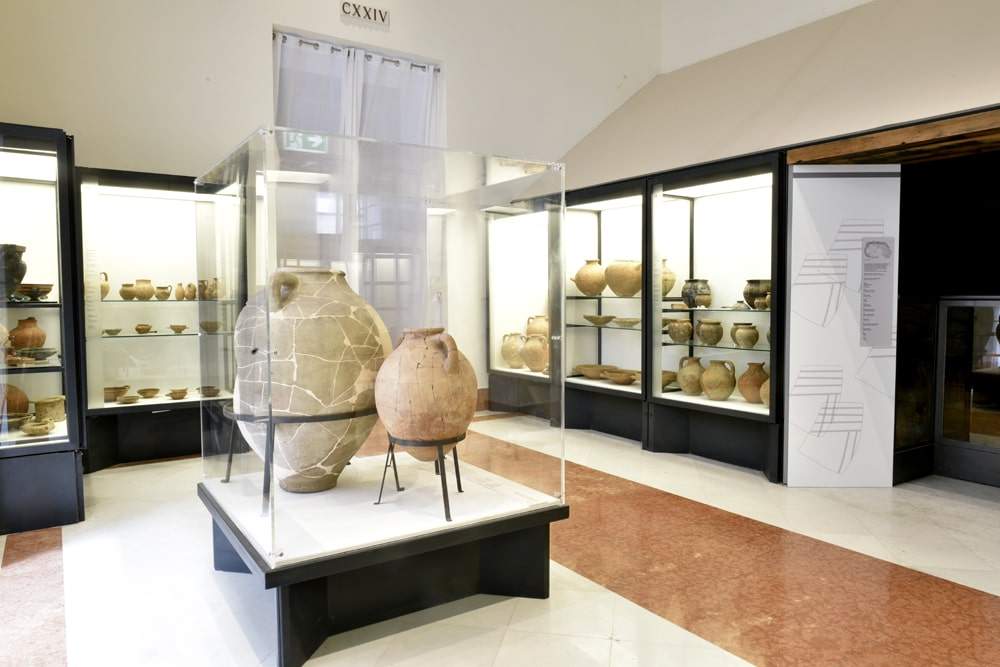Naples National Archaeological Museum reopens Prehistory and Protohistory section after 20 years
After being closed for more than two decades, the National Archaeological Museum of Naples (MANN) reopened the Prehistory and Protohistory section on Feb. 28: it consists of eight rooms, for a permanent exhibition of more than 3,000 artifacts on three levels, totaling more than 1,000 square meters of floor space that tell the story of man from the Lower Paleolithic to theIron Age.
The tour proceeds backward, starting from the highest floor, which encloses artifacts from the Lower Paleolithic to the Eneolithic; it passes through an intermediate space, which tells the story of the Bronze Age; at the even lower “stage,” exhibition focus on the Middle and Final Bronze Age and the Early Iron Age. The whole, then, recounts a broad period from 450,000 years ago to the 7th century B.C., is punctuated by some 3,000 artifacts, which testify to the evolutions of human intelligence and, therefore, human skill. The spacious rooms that house the section remain those of the 1995 layout and are contiguous with the Sundial Hall. The visit path reveals the link, at once ideal and real, with the collections of MANN at work, Museum that grows: from the intermediate floor of the Prehistory and Protohistory section, in fact, one literally overlooks the rooms of the Magna Graecia Collection, returned to fruition, with its masterpieces and extraordinary mosaic floors, after a silence of more than two decades. And the circle will not close here, because from Prehistory and Protohistory will unravel, in fact, the “topographic” itinerary that will lead to the inauguration of the section on Cumae (December 2021) and the one on Neapolis (December 2022).
The tour of the Prehistory and Protohistory section starts from the first room (“The Paleolithic”), tells how the communities nomads begin to organize themselves, living by hunting and gathering, staying in caves or shelters made of perishable materials (Lower Paleolithic, 450,000 to 130,000 years ago), then moves on to explore the world of Neanderthal man (Middle Paleolithic, 130,000 to 40,000 years ago), and arrives at the era marked by the rise of Homo sapiens, with communities living in base camps, formed by covered and internally organized structures (Upper Paleolithic, 40 thousand to 10 thousand years ago). The next room is devoted to the Neolithic, the New Stone Age, a phase of Prehistory that developed between 10 thousand and 5 thousand years ago: with a kind of revolution from the previous lifestyle, communities began to take root in the territories, adopting sedentary habits and engaging in agriculture and animal husbandry. With the third room (“The Eneolithic”), theCopper Age is investigated, from the 3rd to the 2nd millennium B.C.: this period, with its dubious temporal partitioning, is connoted by further organization of human communities and important technological innovations (application of metallurgy to production activities, creation of plow and wheel prototypes). Ascending to the second level, we come to theBronze Age halls (2200 to 900 BCE), which systematizes the growing complexity, already extrinsic in the Eneolithic, of human communities: in the Bronze Age, the first forms of social elites are grafted in, manifested by the power of arms and the control of livestock and mining areas. We go up to the third level again and reach the penultimate room (“The Middle Bronze Age”), ending the tour with the Early Iron Age room (c. 900-730/20 B.C.).
“A new narrative for the oldest journey of man,” comments MANN director Paolo Giulierini. "With the reopening of the Prehistory and Protohistory section we rediscover, after a quarter of a century, the sense of an identity collection of our MANN. Thanks to an impressive and meticulous work of rearrangement and enhancement of the precious artifacts from Campania and the South, from today it will be easier for visitors to orient themselves among the eras, to understand human evolution but also to deepen their knowledge of our territory and imagine when in the Paleolithic period, to give just one example, the island of Capri, at one with the land, was inhabited by hippopotami and rhinoceroses. That of Prehistory we want to be a living section: from next April, it will host its first site-specific exhibition, dedicated to the French comics master Moebius, in collaboration with COMICON. Because, just as in art (from Cézanne to Pablo Picasso to Paul Klee, from Joan Miró to Keith Haring), there is so much prehistory also in contemporary culture and in our ’pop’ imagery. Just think of the opening scene of Stanley Kubrik’s 2001 A Space Odyssey, of the bone thrown by the primitive hominid to the notes of Also sprach Zarathustra; of Breadbury’s man from the future who, hiking through prehistory, causes thebutterfly effect; and again, to the cartoons of our childhood, from Ancestors to Ice Age and the Croods, but also to Roy Lewis’ The Greatest Ape Man of the Pleistocene, and to so much cinema from In the Lost World to Jurassik park. So to each his suggestions, with an invitation for audiences of all ages to find them and reflect on the origins of man in clear and engaging scientific path. History before history therefore returns to the halls of the MANN and to accompany this important stage in the growth of the Museum continues until May 31, in Italian exclusivity, theexhibition Lascaux 3.0."
 |
| Naples National Archaeological Museum reopens Prehistory and Protohistory section after 20 years |
Warning: the translation into English of the original Italian article was created using automatic tools. We undertake to review all articles, but we do not guarantee the total absence of inaccuracies in the translation due to the program. You can find the original by clicking on the ITA button. If you find any mistake,please contact us.



























